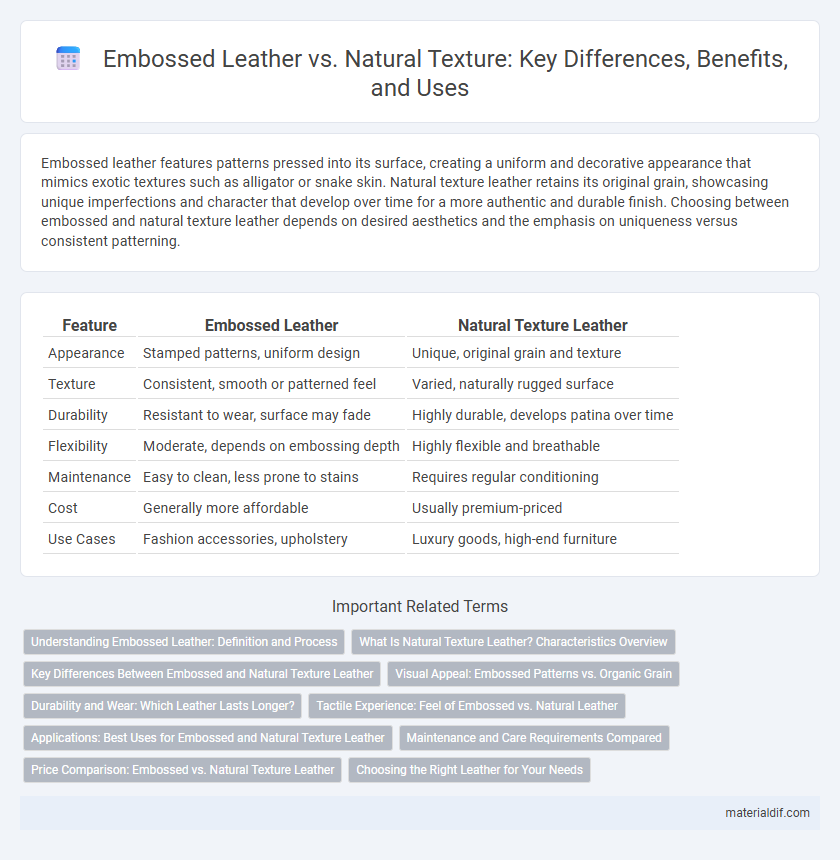Embossed leather features patterns pressed into its surface, creating a uniform and decorative appearance that mimics exotic textures such as alligator or snake skin. Natural texture leather retains its original grain, showcasing unique imperfections and character that develop over time for a more authentic and durable finish. Choosing between embossed and natural texture leather depends on desired aesthetics and the emphasis on uniqueness versus consistent patterning.
Table of Comparison
| Feature | Embossed Leather | Natural Texture Leather |
|---|---|---|
| Appearance | Stamped patterns, uniform design | Unique, original grain and texture |
| Texture | Consistent, smooth or patterned feel | Varied, naturally rugged surface |
| Durability | Resistant to wear, surface may fade | Highly durable, develops patina over time |
| Flexibility | Moderate, depends on embossing depth | Highly flexible and breathable |
| Maintenance | Easy to clean, less prone to stains | Requires regular conditioning |
| Cost | Generally more affordable | Usually premium-priced |
| Use Cases | Fashion accessories, upholstery | Luxury goods, high-end furniture |
Understanding Embossed Leather: Definition and Process
Embossed leather is created by pressing a textured pattern onto natural leather using heat and pressure to replicate the appearance of exotic or intricate surface designs. This process enhances durability and allows for consistent, customizable patterns that may not naturally occur in the leather grain. Unlike natural texture, embossed leather offers uniformity and design versatility while maintaining the leather's inherent strength and flexibility.
What Is Natural Texture Leather? Characteristics Overview
Natural texture leather showcases the authentic grain and surface imperfections of animal hide, reflecting its unique origin without artificial alterations. Its characteristics include visible pores, scars, and inconsistent patterns that enhance durability and offer a distinct tactile experience. Unlike embossed leather, natural texture leather ages gracefully, developing a rich patina that signifies genuine quality and craftsmanship.
Key Differences Between Embossed and Natural Texture Leather
Embossed leather features a patterned surface created through heat and pressure, offering consistent texture and design versatility, while natural texture leather retains the original grain and markings unique to each piece, showcasing authentic characteristics and natural imperfections. Embossed leather provides enhanced durability and resistance to wear, making it ideal for uniformity in fashion and upholstery, whereas natural texture leather develops a patina over time, reflecting aging and usage that enhances its aesthetic. The choice between embossed and natural texture leather depends on preference for either controlled design uniformity or the organic, individualized appearance of genuine leather grains.
Visual Appeal: Embossed Patterns vs. Organic Grain
Embossed leather features precise, repeatable patterns that enhance visual appeal through intricate designs and uniform texture, offering a tailored aesthetic for fashion and upholstery. Natural texture leather displays organic grain patterns that create unique, one-of-a-kind surfaces characterized by irregularities and depth, reflecting the animal's natural skin. The choice between embossed patterns and organic grain depends on the desired style, with embossed leather providing consistent artistic motifs and natural texture emphasizing authenticity and rugged charm.
Durability and Wear: Which Leather Lasts Longer?
Embossed leather, created by pressing patterns onto the hide, often features a protective finish that enhances its resistance to scratches and stains, making it more durable in high-use applications compared to natural textured leather. Natural texture leather, prized for its unique grain and breathability, tends to develop a distinctive patina over time but may be more susceptible to wear and surface damage without proper care. For longevity, embossed leather generally offers better wear resistance, while natural texture leather requires regular maintenance to preserve its durability and appearance.
Tactile Experience: Feel of Embossed vs. Natural Leather
Embossed leather features a raised or patterned surface created through heat and pressure, offering a consistent tactile sensation that enhances grip and decorative appeal. Natural leather retains its organic texture with unique grain patterns and subtle imperfections, providing a softer, more supple feel that evolves with wear and age. The tactile experience of embossed leather is uniform and structured, while natural leather delivers a rich, variable touch that many users find more authentic and luxurious.
Applications: Best Uses for Embossed and Natural Texture Leather
Embossed leather is ideal for fashion accessories, upholstery, and automotive interiors due to its ability to mimic exotic textures and withstand heavy use while maintaining a consistent pattern. Natural texture leather, prized for its unique grain and durability, is best suited for premium furniture, high-end handbags, and bespoke footwear where authentic appearance and tactile experience are essential. Both types offer distinct advantages, with embossed leather providing design versatility and natural texture emphasizing individuality and natural patina development.
Maintenance and Care Requirements Compared
Embossed leather, characterized by its stamped patterns, generally requires less intensive maintenance than natural texture leather, as the embossed surface can better mask minor scuffs and wear. Natural texture leather demands regular conditioning and careful cleaning to preserve its original grain and prevent drying or cracking due to environmental exposure. Both types benefit from avoiding excess moisture and heat, but natural texture leather's porous surface necessitates more frequent and gentle care to maintain its appearance and durability.
Price Comparison: Embossed vs. Natural Texture Leather
Embossed leather typically costs less than natural texture leather due to its manufacturing process, which involves stamping patterns onto lower-grade hide, reducing material waste and labor intensity. Natural texture leather, harvested from higher-quality hides with minimal processing to preserve grain, commands a premium price for its durability and unique aesthetic appeal. The price difference reflects the balance between customization in embossed leather and the authentic, high-end finish of natural grain leather.
Choosing the Right Leather for Your Needs
Embossed leather features a patterned surface created by pressing designs onto natural hide, offering a consistent texture ideal for stylish, durable products. Natural texture leather retains the original grain and imperfections of the hide, providing unique character and superior breathability favored in premium upholstery and fashion. Selecting between embossed and natural texture leather depends on desired aesthetics, durability requirements, and maintenance preferences.
Embossed Leather vs Natural Texture Infographic

 materialdif.com
materialdif.com